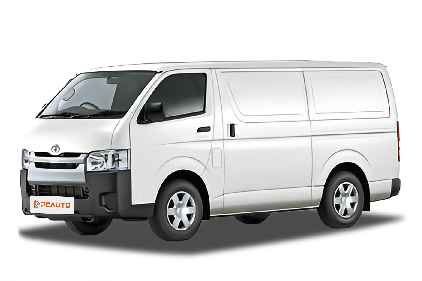Q
Toyota Hiace how many seats
The Toyota Hiace is a staple in Malaysia's commercial and family vehicle scene, with seating options that vary by trim. The standard models, like the Hiace Van, typically offer 12 to 15 seats—perfect for commercial shuttle services or group outings. On the flip side, the more upscale variants such as the Hiace Super Grandia trim down to 9 to 11 seats, prioritizing comfort with premium upholstery and rear air-conditioning, ideal for family trips or business reception. It is worth noting that some aftermarket shops also offer custom seating configurations, such as adjusting to 13 seats or reducing to 8 seats to flexibly adapt to different uses. For Malaysian buyers, the Hiace's biggest draws are its legendary durability, high ground clearance that handles local road conditions like a champ, and wallet-friendly maintenance costs. The diesel engine variants, in particular, stand out for their impressive fuel efficiency. For the most accurate specs, though, your best bet is to hit up a Toyota Malaysia authorized dealer. They can walk you through the latest model year details, including safety features like ABS and dual airbags—stuff that could definitely sway your final purchase call.
Special Disclaimer: This content is published by users and does not represent the views or position of PCauto.
Related Q&A
Q
how much is Toyota Hiace bus
The Toyota Hiace van's pricing in Malaysia can vary quite a bit depending on the trim level, model year, and market demand. Brand-new ones typically range from around RM200,000 to RM400,000. That all hinges on things like how many seats it has, the engine type—diesel or petrol—and extra features such as air conditioning and nicer seats.
For used Hiace vans, the price fluctuates even more based on age, mileage, and overall condition. You're looking at roughly RM80,000 to RM250,000 for a pre-owned model.
What makes the Hiace such a hit here? It's all about that tough-as-nails reliability, spacious interior, and low maintenance costs. Both businesses and families love it, especially for long road trips or shuttling groups around. The Malaysian market usually sees two main variants: the standard version and the high-roof variant. The high-roof option gives you better headroom, which is great if you're after a bit more comfort.
On top of that, the Hiace's fuel efficiency and solid dependability keep it pretty competitive in the local market. Toyota's got service centers all over the country, and parts are easy to come by, which helps keep those long-term running costs down too.
If you've got specific needs in mind, I'd recommend popping by your nearest Toyota dealership. They can hook you up with the latest prices and any ongoing promotions. And hey, take it for a test drive while you're there—get a feel for how it drives and really see if it fits what you're looking for.
Q
how long is Toyota Hiace
Toyota Hiace dimensions vary by model and generation, but here in Malaysia, the current fifth-gen version (around since 2019) is what you'll mostly see. The standard wheelbase clocks in at roughly 5,265mm, while the long wheelbase stretches out to 5,915mm. This sizing strikes a solid balance—nimble enough for zipping through city streets, yet roomy enough to handle both passengers and cargo.
It’s no wonder the Hiace is a top pick for Malaysian businesses and big families alike. That length directly impacts how much it can carry. The standard model, for example, can fit 12 to 14 seats, making it great for group transport. The long-wheelbase? Perfect for tour vans needing extra luggage space or logistics work where cargo capacity matters more.
But here’s the thing Malaysian buyers need to remember: our local roads. Tight city streets and parking garages with height limits can be tricky. Luckily, the Hiace’s compact height (around 1,990mm) handles those spots pretty well.
Oh, and if you’re looking at used models, the Hiace holds its value surprisingly well. Durability and easy maintenance are big reasons why. Just a pro tip: keep an eye on the suspension system if you’re hauling heavy loads regularly—staying on top of that will keep you safe on the road for years to come.
Q
how much is a Toyota Hiace van
In Malaysia, the price of a Toyota Hiace van can vary quite a bit depending on the model, specs, year, and how the market's moving. New ones typically run between 150,000 to 250,000 Ringgit. It really hinges on the trim you go for—like the standard or the more decked-out luxury version—and whether you add extras such as air conditioning or advanced safety systems.
For used Hiaces, the price fluctuates based on condition, mileage, and how old the van is, usually landing in the 80,000 to 150,000 Ringgit range.
The Hiace has built a solid rep here for being tough as nails and offering serious cargo-hauling capability, making it a top pick for businesses—think logistics, deliveries, or even converting it into a passenger van. Its reliable engine and low maintenance costs are big reasons it’s such a hit in the Malaysian market. Plus, with its roomy interior and flexible seating/layout options, it’s also a solid choice for family trips or group outings.
If you’re looking to pick one up, I’d recommend chatting with your local dealer to get the latest quotes and any ongoing promotions. And don’t forget to factor in long-term costs and warranty coverage too—that stuff matters.
Q
how much is a Toyota Hiace?
In Malaysia, the Toyota Hiace comes with a range of price tags depending on the model, specs, and year. Brand-new ones typically go for between RM150,000 to RM250,000, and that all hinges on which variant you pick—like the Standard, Deluxe, or Commercial trim. As for used Hiaces, you're looking at anywhere from RM50,000 to RM150,000, with condition and mileage being the big factors there.
Malaysian buyers can't get enough of the Hiace, and it's easy to see why. It's built tough, offers loads of space, and doesn't guzzle fuel—perfect whether you're shuttling the family around or using it for business. Safety-wise, it's got your back with features like ABS and multiple airbags, so both driver and passengers stay protected.
On top of that, keeping a Hiace on the road won't break the bank. Maintenance costs are reasonable, parts are easy to find, and repairs are straightforward—all reasons it's been a mainstay in Malaysia for so long. If you're thinking about getting one, my advice is to figure out what you really need in terms of specs, then head to an authorized dealer for a test drive. That way, you can make sure it checks all your boxes before you commit.
Q
For the commercial vehicle model, where is the fuse box located in the Toyota Hiace?
Hey there, fellow Hiace drivers! Let's talk about where to find the fuse box in your Toyota Hiace Commuter. This workhorse usually tucks its fuse box behind the side panel under the driver's seat. Some models might also have one in the engine bay, near the battery. But hey, it can vary a bit depending on the year and trim, so your best bet is to hit up the "Electrical System" section in your owner's manual – or just flip open the fuse box cover and check the diagram on the back.
That fuse box is like the gatekeeper for your van's electrical system. If your headlights, AC, or cigarette lighter suddenly call it quits, the first thing to do is check if the corresponding fuse has blown. And when replacing a fuse, stick to the same amperage rating – don't get creative there!
Day-to-day, keep that fuse box dry and clean to avoid any short circuits. If the same fuse keeps blowing, that's a red flag – you might have a wiring issue that needs a pro's touch, so don't delay getting it checked out.
The Toyota Hiace is a staple in Southeast Asia, and its electrical system is built to handle those tropical conditions, but regular checks are still part of good maintenance. For other common stuff like battery care or adjusting the lights, the owner's manual is your go-to guide. Keep rollin'!
Q
How many models does Toyota Hiace have
The Toyota Hiace is a total workhorse and family favorite here in Malaysia, killing it in both commercial and personal use. You’ll mainly find a few go-to variants cruising our roads: the standard Hiace Van, the Hiace Commuter (that’s the people-hauler), and the top-dog Hiace Super Grandia (the luxury liner). These aren’t just badge swaps—they’re built for different jobs. The Hiace Van? It’s all about getting cargo from A to B, no frills, just space. But the Commuter and Super Grandia? They’re where comfort takes the wheel, packing nicer seats, better air-con, and all that extra kit to keep passengers happy.
Under the hood, Toyota’s got you covered with diesel and petrol engine options, so whether you’re after torque for heavy loads or something smoother for daily drives, there’s a Hiace for that. Malaysians swear by this van for a reason—its legendary durability and rock-solid resale value are huge wins. Plus, that cavernous interior and flexible seating? Perfect for everything from running a business to shuttling the whole family (and then some).
If you’re thinking of adding a Hiace to your fleet or driveway, do yourself a favor: figure out what you’ll *really* use it for, then hit up your nearest authorized dealer for a test drive. Trust me, you’ve gotta feel that space and drive to get the full picture.
Q
toyota hiace how many seater
The Toyota Hiace is a total workhorse and family favorite here in Malaysia, killing it in both commercial and personal use. Seating? It varies by model and spec, but the standard versions typically roll with 12 to 15 seats—perfect for big families hitting the road or businesses shuttling folks around. Need more? The high-roof variants often up the ante on seating options to fit even bigger crews. What really makes the Hiace stand out is its roomy interior, rock-solid reliability, and comfy ride—ideal for those long Malaysian road trips or when you’re hauling passengers all day. Under the hood, you’ve got choices too: diesel or petrol engines, so you can pick what suits your driving style and fuel habits best. And for the cargo haulers? There’s a van version where you can fold or yank out the rear seats to free up tons of space. Let’s not forget its tough-as-nails build and low maintenance costs—no wonder it’s the go-to for so many Malaysian businesses and families. Whether it’s daily commutes or commercial runs, the Hiace just gets the job done, and done well.
Latest Q&A
Q
Is the Hyundai Santa Fe 2019 a good car?
The 2019 Hyundai Santa Fe is a well-rounded SUV that's particularly family-friendly. It comes with either a 2.4L or 2.0L turbocharged engine, delivering smooth power delivery and decent fuel efficiency – perfect for both city commutes and road trips. The cabin offers generous space, though the third row is best suited for kids or short journeys.
Inside, you'll find above-average materials and build quality for its class, along with tech goodies like an 8-inch touchscreen, Apple CarPlay, and Android Auto. Safety isn't an afterthought either – it comes standard with forward collision warning, lane-keeping assist, and other active safety tech.
Driving dynamics lean toward comfort rather than sportiness, so it's not for thrill-seekers. Resale value is mid-pack, but maintenance costs are reasonable. With solid local ownership and a widespread service network, the Santa Fe makes a practical choice. If you're after a spacious, feature-packed family hauler with good reliability, this one's worth a look – though we'd recommend test-driving some Japanese and European rivals in the segment before deciding.
Q
How long will a 2019 Hyundai Santa Fe last?
The 2019 Hyundai Santa Fe typically lasts around 200,000 to 300,000 kilometers with proper maintenance and normal driving conditions, though its actual lifespan depends on the owner's care habits and operating environment.
Equipped with either a 2.4L or 2.0T engine paired with a 6-speed automatic transmission, the powertrain is proven to be reliable. Staying on top of key services like oil changes, transmission flushes, and timing belt replacements will go a long way in keeping it running smoothly.
The body's rust protection holds up decently in tropical climates, but it's wise to check the undercarriage annually and rinse the car frequently during rainy seasons to preserve the paint.
Maintenance costs are mid-range for the midsize SUV segment, and parts availability is generally good, which helps keep long-term ownership affordable. Resale value is about average—expect 40%-50% retention after five years.
If you plan to keep it long-term, pay extra attention to carbon buildup in the engine, transmission fluid intervals, and suspension wear—these factors really impact durability down the road. Stick to the factory maintenance schedule and keep detailed records; it’ll not only maintain performance but also help with resale value later.
Q
What kind of engine does the 2019 Santa Fe have?
The 2019 Santa Fe offers two engine options to suit different driving preferences. The standard 2.4-liter naturally aspirated four-cylinder delivers 185 horsepower and 178 lb-ft of torque – perfectly adequate for daily commuting. For those who want more punch, the available 2.0-liter turbocharged four-cylinder pumps out a healthier 235 hp and 260 lb-ft of torque. Both engines pair with a smooth-shifting 8-speed automatic transmission that balances performance and fuel efficiency.
Turbocharging is becoming increasingly common in midsize SUVs like this, as it squeezes out extra power without increasing displacement. With direct injection and variable valve timing, the turbo engine manages decent fuel economy too – making it particularly appealing for drivers who frequently navigate stop-and-go traffic or take long highway trips. On the other hand, the naturally aspirated engine wins points for its simpler mechanics and lower maintenance costs. Ultimately, it comes down to whether you prioritize power or practicality.
Q
Should I buy a 2019 Hyundai Santa Fe?
The 2019 Hyundai Santa Fe is a solid contender in the midsize SUV segment, offering a spacious interior and a practical three-row seating layout—perfect for families. Under the hood, you’ve got the choice of a smooth 2.4L or a peppy 2.0L turbocharged engine, both delivering decent fuel efficiency for the class.
Safety is a strong suit here, thanks to Hyundai’s SmartSense suite, which includes forward collision warning, lane-keeping assist, and adaptive cruise control. Inside, the cabin keeps things simple and functional, with materials and fit-and-finish that punch above their price point. The infotainment system supports Apple CarPlay and Android Auto, so daily connectivity is a breeze.
On the used market, the 2019 Santa Fe offers good value, but always check the service history and pay extra attention to the engine and transmission condition. Hyundai’s widespread dealer network also makes maintenance relatively hassle-free.
If you’re after a roomy, well-equipped, and reliable family hauler, the 2019 Santa Fe is worth a look—though it wouldn’t hurt to cross-shop it with rivals like the Honda CR-V or Mazda CX-5 to see what fits your needs and budget best.
Q
How much does a 2019 Santa Fe cost?
The 2019 Santa Fe's price varies depending on condition, trim level, and mileage. When new, it was priced around RM150k to RM200k, depending on the powertrain (like the 2.4L naturally aspirated or 2.0T turbo) and whether it had AWD. On the used market, you'll typically find them between RM80k and RM120k, though well-maintained low-mileage high-spec models can fetch close to RM150k.
This seven-seater has been popular with families thanks to its spacious cabin and strong safety features—think smart cruise control and blind-spot monitoring. The Hyundai SmartSense suite also gives it a solid edge in active safety tech for its class.
If you're eyeing a used Santa Fe, pay extra attention to service history and suspension components. Its comfort-tuned suspension means rubber bushings tend to wear over time. Cross-shop it with rivals like the Honda CR-V or Mazda CX-8 at this price point, but the Santa Fe pulls ahead on cabin space (especially adult-friendly third-row legroom) and standard kit.
Pro tip: Some dealers now offer certified pre-owned units with extended warranties—worth asking about before pulling the trigger.
View MoreRelated News

Toyota HiAce and Mitsubishi Outlander upgraded to receive five-star safety rating
WilliamSep 24, 2025

Toyota unveils the new Corolla at the Auto Guangzhou in China. What changes will the future Corolla have?
AshleyNov 25, 2025

Why is the facelifted GR Yaris considered the finished product?
AshleyNov 21, 2025

Toyota is developing two new Land Cruiser models, will Land Cruiser become an independent brand in the future?
JamesNov 20, 2025

Toyota Supra (A90) will be discontinued next March, and the next generation model may be led by Toyota.
JohnNov 14, 2025
View More















Pros
Cons